
An enchanting farm for wildlife
When looking down on Alberta in Canada using Google Earth, much of the landscape is made up of a patchwork of half-mile-square blocks with an effect that looks like maths paper with each square coloured in a different shade of green. Zoom in more closely at the area south east of Calgary, south of a line between McGregor Lake and Lake Newell, and you’ll notice that many of these blocks contain a circle with a quarter mile radius. These are irrigation ‘pivots’ bringing water to the highly managed cropped landscape. This is homogenous farmland with not a lot going on except cropping; there’s little natural water, so it’s not conducive to thriving wildlife.
But there is one area in this homogeneity that stands out as different. It still has the pivots and the circular ‘fields’, but in almost every block there’s a man-made wetland. Meet Enchant Farm.
The 1,460-acre Enchant Farm is family-owned with a third party operating the agricultural business. As well as relying on the farming being profitable, the owners have a passion for wildlife conservation. The Haggins family want to bring back biodiversity into their farm and, to help in their efforts, they sought advice from the Alberta Conservation Association (ACA) to improve the habitat at Enchant. One of the ACA’s team, Dr Doug Manzer, has been a key adviser, and in turn has bounced ideas off conservationists in the UK including Dr Dave Butler of Perdix.
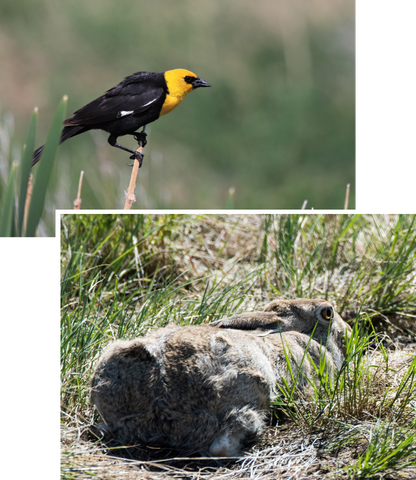
The Haggins also have a passion for game bird shooting and wish to see self-supporting and sustainable populations of pheasants and grey partridges on their land so that a few can be taken ‘for the pot’ each year with friends and family. Although these species thrived after being introduced to Alberta more than a century ago, declines in habitat through intensive farming have caused numbers of farmland birds to drop in many areas. However, unlike in the UK and Europe where farmers can apply for government grants to pay for habitat restoration and creation, in this part of North America there are no such payments available and so they must be funded privately. The Haggins passion for game bird shooting provided the incentive for them to invest their own money into an extensive habitat creation project that aimed to increase not only pheasant and partridge numbers but also native ground-nesting birds such as meadowlarks.
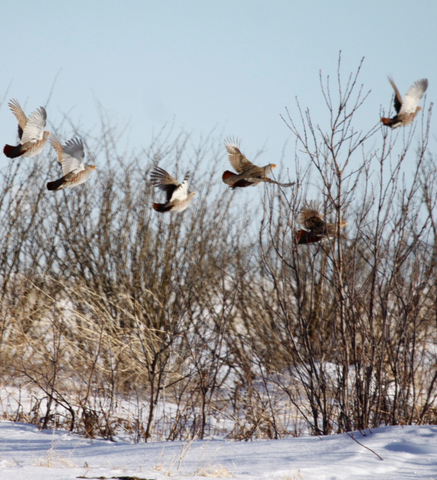
So what has Enchant done?
Wetlands
First has been the creation of scrapes and ponds where water can accumulate and flow into further scrapes as the first ones fill. These are dry for some of the year but store and retain water for longer than anywhere else on the farm, almost acting as a landscape-scale sponge, protecting the farmland from run-off and flooding further downstream.
Where there had been just a half dozen or so of these ‘wetlands’ ten years ago, the Haggins have carved out a further two dozen or more spread over the farm to provide the habitat associated with water across the area. Cattail vegetation colonises the flood-plain areas of these wetlands, and provides safe cocoons for wildlife within the clumps of vegetation. Cattail has a micro-climate of warmth which is particularly valuable during the harsh winters when temperatures drop below freezing for half of the year and snow is often deep. This is a haven for pheasants when temperatures plumet for a week or two at time between November and April.
Plantings
Back in the 1930s, shrub plantings to catch the wind-borne soils were a common feature of the Canadian farmed landscape, but they have been removed across most of the area; however, Enchant is thwarting this trend and putting many back in to create vitally important vertical structure. In the UK, we’d think of them as hedgerows, and they play a multifaceted role on Enchant Farm. These banks of shrubs are planted in several parallel rows around the perimeter of the irrigated fields, so wildlife can move through them easily. They act as snow catchers through winter, with drifts occurring on the downwind side. They are used strategically in several locations to reduce the snow-load in vital winter habitat such as the cat-tail marshland previously mentioned. They also reduce the loss of loamy soils that are whipped up by the wind travelling across the bare fields. And critical for gamebirds, these plantings provide a refuge for wildlife against aerial predators, particularly raptors. The shrubs are kept low (under three to four metres height) so that raptors and corvids are denied perches and nest sites and are therefore discouraged from taking up residence.
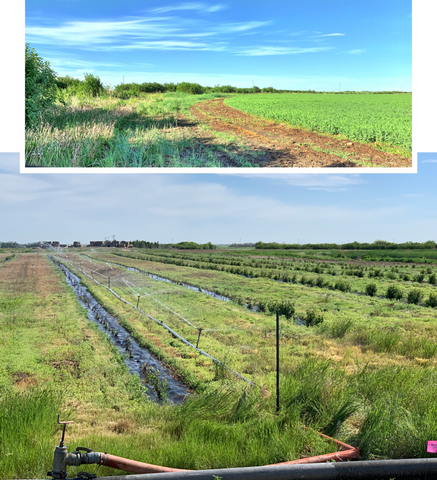
All of the cropped fields at Enchant Farm have adopted a three-pronged approach to improve the success of grey partridges and pheasants. This includes a three-metre headland planted with perennial herbaceous plants (‘forbs’) which provide a great area for brood rearing as chicks are able to move freely between the plants. These are rich in insect life (including valuable crop pollinators), providing high protein foraging for the chicks. The shrub rows described above are the second layer of this habitat sandwich; with the third and outside layer beyond the shrub row being again a mix of insect-rich forbs and tussocky grasses providing nesting and brood habitat. Together these plants provide hens with the resources to rear broods successfully without moving too far.
Predation
Well-orchestrated predator control of the type found in the UK is rarely undertaken in Alberta. The apex predators on this landscape were once grizzly bears and wolves, but now the lowly coyote is king. Enabling a resident pair of coyotes to live on the farm isn’t as crazy as it may first sound. The territorial pair will keep other ground predators at bay, thus effectively protecting the vulnerable birds. Several years ago, the resident coyote pair were killed, likely by someone thinking they were doing a helpful service. Instead, the farm quickly became a free for all with a noted increase in mammalian predators including foxes, skunks, mink and racoons. There was also a heightened increase in dispersing coyotes passing through and grabbing a free lunch. The Haggins are hoping a new coyote pair will carve out this farm as their territory again soon and keep the overall predator count down.
Corvids (crows and magpies) are key nest predators, as they are in the UK. But in the UK when corvids are a problem, managers wishing to help vulnerable species find that trapping using Larsen traps is highly effective and efficient when used during the breeding season. In Alberta, Larsen traps are rarely used, so instead the Haggins manage the land at Enchant to keep preferred nesting habitat for these birds to a minimum.
Feeding
Enchant provides supplementary feeding for the pheasants and partridges. For feeders, they use the Perdix port feeders, but rather than the containers typically found on UK pheasant shoots, those at Enchant Farm need to be on stands that can be raised or lowered depending on the snow depth. Being able to buy just the feeder port from Perdix (without having to buy the bucket too) has both saved on unnecessary transport costs, but has also allowed flexibility in designing suitable hopper systems. Like in the UK, the feed provided is a life-line to other wildlife, not just the pheasants and partridges, at key times and in harsh weather. Trail cameras, both SD card and cellular-enabled, were installed on gamebird feeders to monitor use.
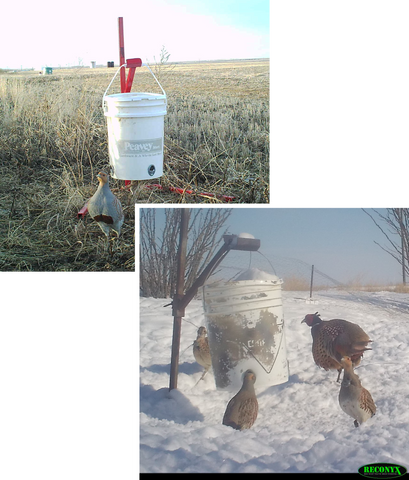
Releasing pheasants
Pheasants at Enchant Farm have been released using a system similar to that found in the UK, which involves releasing young birds (poults) at six weeks old. This has resulted in around 40 to 50 breeding hen pheasants on the farm earlier this spring, with the hope that a self-sustaining population is taking foot.
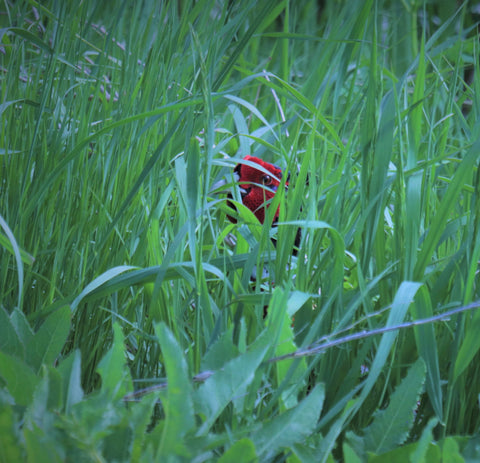
Advice
Doug explains how Perdix has helped in Enchant’s journey: “Dave really helped us to gain a vision of what is possible. We have used his experience to adapt ideas for North America. It has been a valuable insight. He has provided a nuanced approach to establishing pheasants and partridges on the farm and being at the end of an email or WhatsApp, he has been able to answer specific management questions and queries.”
Results
Across nearby non-improved farms monitored for comparison, there is a grey partridge spring density of between one and three pairs per square kilometre. The densities at Enchant Farm have tracked roughly eight to 10 times greater than this over the past 10 years. Over the last few (somewhat difficult) years at Enchant, the comparable average is eight to nine pairs per square kilometre, although the count in spring 2023 recovered back to 17. The best in the past has been 35 spring pairs per square kilometre averaged across the whole farm, which equated to around 200 partridge per square kilometre in the autumn after the breeding season.
It’s not just the gamebirds that have done well at Enchant. Noticeable at Enchant has been the number and diversity of song birds, amphibians, and ducks compared with non-improved areas monitored nearby. And there is also a marked increase in insect life, including valuable pollinators necessary for the crops. So the whole project looks like being a win-win for wildlife and the farmed environment. We will keep you updated on progress in future articles.
Many thanks to Dr. Doug Manzer for his help in writing this article and providing all of the images shown.

